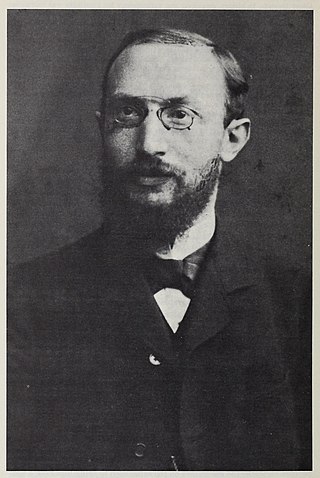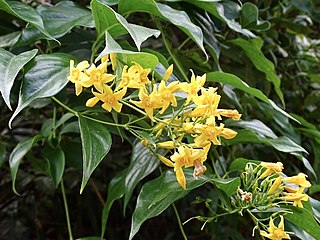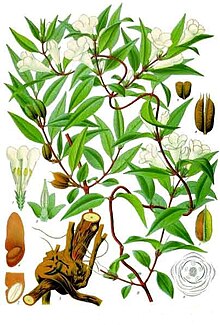
Theobromine, also known as xantheose, is the principal alkaloid of Theobroma cacao. Theobromine is slightly water-soluble (330 mg/L) with a bitter taste. In industry, theobromine is used as an additive and precursor to some cosmetics. It is found in chocolate, as well as in a number of other foods, including the leaves of the tea plant, and the kola nut. It is a white or colourless solid, but commercial samples can appear yellowish.

Laudanum is a tincture of opium containing approximately 10% powdered opium by weight. Laudanum is prepared by dissolving extracts from the opium poppy in alcohol (ethanol).

Plantago is a genus of about 200 species of flowering plants in the family Plantaginaceae, commonly called plantains or fleaworts. The common name plantain is shared with the unrelated cooking plantain. Most are herbaceous plants, though a few are subshrubs growing to 60 centimetres tall.

Gentianales is an order of flowering plant, included within the asterid clade of eudicots. It comprises more than 20,000 species in about 1,200 genera in 5 families. More than 80% of the species in this order belong to the family Rubiaceae.

Aconitine is an alkaloid toxin produced by various plant species belonging to the genus Aconitum, known also commonly by the names wolfsbane and monkshood. Monkshood is notorious for its toxic properties.

Strychnine is a highly toxic, colorless, bitter, crystalline alkaloid used as a pesticide, particularly for killing small vertebrates such as birds and rodents. Strychnine, when inhaled, swallowed, or absorbed through the eyes or mouth, causes poisoning which results in muscular convulsions and eventually death through asphyxia. While it is no longer used medicinally, it was used historically in small doses to strengthen muscle contractions, such as a heart and bowel stimulant and performance-enhancing drug. The most common source is from the seeds of the Strychnos nux-vomica tree.

Myristicin is a naturally occurring compound found in common herbs and spices, such as nutmeg. It is an insecticide, and has been shown to enhance the effectiveness of other insecticides.

Conium is a genus of flowering plants in the family Apiaceae. As of December 2020, Plants of the World Online accepts six species.

Gelsemium sempervirens is a twining vine in the family Gelsemiaceae, native to subtropical and tropical America: Honduras, Guatemala, Belize, Mexico, and southeastern and south-central United States. It has a number of common names including yellow jessamine or confederate jessamine or jasmine, Carolina jasmine or jessamine, evening trumpetflower, gelsemium and woodbine.

Curare is a common name for various alkaloid arrow poisons originating from plant extracts. Used as a paralyzing agent by indigenous peoples in Central and South America for hunting and for therapeutic purposes, curare only becomes active when it contaminates a wound or is introduced directly to the bloodstream; it is not active when ingested orally. These poisons cause weakness of the skeletal muscles and, when administered in a sufficient dose, eventual death by asphyxiation due to paralysis of the diaphragm. Curare is prepared by boiling the bark of one of the dozens of plant sources, leaving a dark, heavy paste that can be applied to arrow or dart heads. In medicine, curare has been used as a treatment for tetanus and strychnine poisoning and as a paralyzing agent for surgical procedures.

Adonis vernalis, known variously as pheasant's eye, spring pheasant's eye, yellow pheasant's eye and false hellebore, is a perennial flowering plant in the buttercup family Ranunculaceae. It is found in dry meadows and steppes in Eurasia. More specifically, this plant grows in a wide range of locations which include open forests, forest clearings, dry meadows, mesic steppe, and mostly calcareous soil. Isolated populations are found from Spain in the west across Central Europe with fine examples in Valais, Switzerland, and southern Europe, reaching southern Sweden in the north and Abruzzo in the south, with its main area of distribution being the Pannonian Basin and the West Siberian Plain. In contrast to most other European Adonis species, the flowers appear in springtime, and are up to 80 mm (3.1 in) in diameter, with up to 20 bright yellow petals. Not only do the flowers begin to grow, but so do the plants aerial organs, from around April to May.

Aconitum carmichaelii is a species of flowering plant of the genus Aconitum, family Ranunculaceae. It is native to East Asia and eastern Russia. It is commonly known as Chinese aconite, Carmichael's monkshood or Chinese wolfsbane. In Mandarin Chinese, it is known as fùzǐ and as wūtóu ; while in Japanese it is named torikabuto.
Viktor Aloisius Reko, was an Austrian teacher and scientific author who moved to Mexico in 1921. He is best known for his popular book Magische Gifte: Rausch- und Betäubungsmittel der Neuen Welt, first published in 1936. This book recorded a number of second-hand observations on New World psychoactive drugs, paraphrased from notes he took of conversations with his cousin, the eminent Mexican ethnobotanist Dr. Blas Pablo Reko, including the first published refutation of Dr. William Edwin Safford's uncharacteristically untenable assertion that teonanácatl was not a mushroom, but a cactus.

Sir Arthur Ignatius Conan Doyle was a British writer and physician. He created the character Sherlock Holmes in 1887 for A Study in Scarlet, the first of four novels and fifty-six short stories about Holmes and Dr. Watson. The Sherlock Holmes stories are milestones in the field of crime fiction.

Louis Lewin was a German pharmacologist. In 1887 he received his first sample of the Peyote cactus from Dallas, Texas-based physician John Raleigh Briggs (1851-1907), and later published the first methodical analysis of it, causing a variant to be named Anhalonium lewinii in his honor.

Gelsemine (C20H22N2O2) is an indole alkaloid isolated from flowering plants of the genus Gelsemium, a plant native to the subtropical and tropical Americas, and southeast Asia, and is a highly toxic compound that acts as a paralytic, exposure to which can result in death. It has generally potent activity as an agonist of the mammalian glycine receptor, the activation of which leads to an inhibitory postsynaptic potential in neurons following chloride ion influx, and systemically, to muscle relaxation of varying intensity and deleterious effect. Despite its danger and toxicity, recent pharmacological research has suggested that the biological activities of this compound may offer opportunities for developing treatments related to xenobiotic or diet-induced oxidative stress, and of anxiety and other conditions, with ongoing research including attempts to identify safer derivatives and analogs to make use of gelsemine's beneficial effects.
Alexander Yurevich Perepilichny was a Russian businessman and whistleblower who died, while jogging near London in 2012, after leaving Russia in 2009.

Gelsemium elegans, commonly known as heartbreak grass, is a poisonous plant of the family Gelsemiaceae found in China and other Asian countries. It contains toxic alkaloids such as gelsemine, gelsenicine, gelsevirine and koumine.

Mostuea is one of only three genera of flowering plants belonging to the small family Gelsemiaceae. Mostuea and Gelsemium were formerly placed in the family Loganiaceae, while Pteleocarpa was placed variously in the families Icacinaceae, Cardiopteridaceae, Boraginaceae, and others, before the description of the Gelsemiaceae was altered formally to accommodate it in 2014. Mostuea is native to Africa and South America. Anecdotal evidence suggests that the roots of certain Mostuea species are used as ritual aphrodisiacs and entheogens in West Tropical Africa.

14-Hydroxygelsenicine (HGE) is a gelsedine-type indole alkaloid naturally found in some plants of the Gelsemium genus. G. elegans was used in traditional Chinese medicine as a remedy for a plethora of conditions such as skin ulcers and dermatitis, pain related to cancer, rheumatic arthritis, psoriasis as well as to treat bone fractures. It can also be found under the names “Duan Chang Cao”, “Gou Wen” and “heartbreak grass”. G. elegans is also known for its toxic effects; it is used by hilltribes of southeastern Asia as an effective means of committing suicide and has been linked to certain types of toxic honey, where HGE was the most abundant component. Gelsedine-type alkaloids from G. elegans usually express high toxicity, with gelsenicine being one of the most toxic. However, toxicity of HGE has not yet been thoroughly researched. More recent studies have shown that alkaloids derived from G. elegans have anti-tumor, anti-inflammatory, analgesic, and immunomodulation properties, with the toxic dose being close to the therapeutic dose.





















